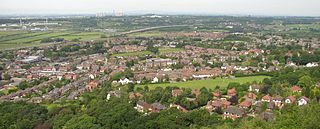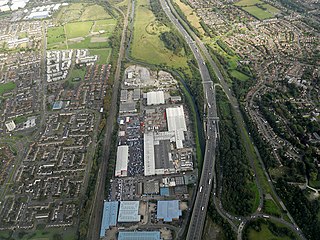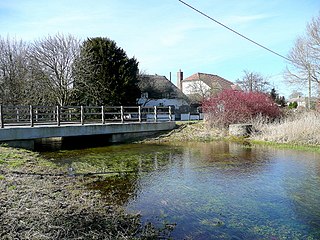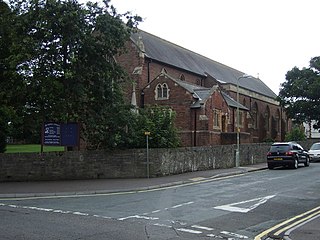
Frodsham is a market town, civil parish, and electoral ward in the unitary authority of Cheshire West and Chester and the ceremonial county of Cheshire, England. Its population in 2021 was 9,300. It is 16 miles (26 km) south of Liverpool and 28 miles (45 km) southwest of Manchester. The River Weaver runs to its northeast and on the west it overlooks the estuary of the River Mersey. The A56 road and the Chester–Manchester railway line pass through the town, and the M56 motorway passes to the northwest.

Porthcawl ( ) is a town and community in the Bridgend County Borough of Wales. It is on the south coast of Wales, 25 miles (40 km) west of Cardiff and 19 miles (31 km) southeast of Swansea.

Newton Aycliffe is a town in County Durham, England. Founded in 1947 under the New Towns Act of 1946, the town is 5 miles to the north of Darlington and 10 miles to the south of Durham. It is the oldest new town in the north of England. Together with the bordering Aycliffe Village and the north part of School Aycliffe, it forms the civil parish of Great Aycliffe. The population of the town at the time of the 2011 census was 26,633.

Corfe Mullen is a village in Dorset, England, on the north-western urban fringe of the South East Dorset conurbation. The community had a population of 10,133 at the 2011 Census. It is served by six churches, four pubs, five schools, a library, various shops and local businesses, a village hall, and many community and sports organisations. On 10 December 2019 The Corfe Mullen Parish Council resolved to adopt Town Council status, citing potential financial benefits. In all other aspects Corfe Mullen is still very much a village, albeit a large one.

Castle Bromwich is a civil parish in the Metropolitan Borough of Solihull in the West Midlands, England. It borders the rest of the borough to the south east, Sutton Coldfield to the east and north east, Shard End to the south west, Castle Vale, Erdington and Minworth to the north and Hodge Hill to the west.

Whitwick is a village and civil parish in the North West Leicestershire district of Leicestershire, England, close to the town of Coalville in the northwest of the county. It lies in an ancient parish which formerly included the equally historic villages of Thringstone and Swannington.

Headcorn is a village and civil parish in the borough of Maidstone in Kent, England. The parish is on the floodplain of the River Beult south east of Maidstone.
Otterbourne is a village in Hampshire, England. It is located approximately four miles (6.4 km) south of Winchester and eight miles (13 km) north of Southampton. At the 2011 census, its population was 1,539, and there were 626 dwellings.

Lustleigh is a small village and civil parish in the Wray Valley, inside the Dartmoor National Park in Devon, England. It is between the towns of Bovey Tracey and Moretonhampstead. The village has often been named amongst the best or prettiest villages in the country in various publications, particularly due to the traditional thatched buildings in the village centre, and local activities such as the Lustleigh Show. This has also led to it being noted as the most expensive rural location to buy a house.

Nottage is a small village part of Porthcawl in Bridgend County Borough, Wales. It is also the name of an electoral ward to the town and county councils.

Docking is a village and ancient civil parish in the north-west of the English county of Norfolk. It is near the North Norfolk Coast Site of Special Scientific Interest.

Barton Stacey is a village and undulating civil parish, which includes the hamlets of Bransbury, Newton Stacey, Drayton and Cocum, in the Test Valley district of Hampshire, England, centred about 7 miles (11 km) south-east of Andover. It is bounded to the north by the estate of Drayton Lodge, and, to the south, by the minor A30 road; both being east–west routes, and connected by The Street/Cocum Road, the main road that bisects the village. The distance between the A303 and A30 at this point is 2 miles (3.2 km), which is twice the width of the parish.

Tasburgh is a civil parish and a village in the south of Norfolk, England, located approximately 8 miles south of Norwich. It lies on the A140 road, north of Long Stratton and south of Newton Flotman. The River Tas flows nearby and Tasburgh Hall lies to the west of the village. The local church is dedicated to St. Mary the Virgin. The village is made up of Upper Tasburgh and Lower Tasburgh. The majority of Lower Tasburgh contains buildings from the early days of the village whilst Upper Tasburgh is made up of more modern housing.
York had around 45 parish churches in 1300. Twenty survive, in whole or in part, a number surpassed in England only by Norwich, and 12 are used for worship. This article consists of a list of medieval churches which still exist in whole or in part, and a list of medieval churches which are known to have existed in the past but have been completely demolished.

Spencerville is a rural community located in Eastern Ontario, within Edwardsburgh/Cardinal township in the United Counties of Leeds and Grenville. The village lies about 80 kilometers southwest of downtown Ottawa on Highway 416. The South Nation River runs through the village.

Newton, also known as Newton Green to distinguish it from Nowton near Bury St Edmunds, and Old Newton near Stowmarket, is a small village and civil parish in Suffolk, England. Part of Babergh district, it is located on the A134 between Sudbury and Colchester, around three miles from the former.

St. James Church is a historic Episcopal church building at 86-02 Broadway in the Elmhurst neighborhood of Queens in New York City. It is the city's oldest surviving Anglican building and Church of England mission church. It is also alternatively called the Old St. James Church to distinguish it from the St. James Episcopal Church two blocks away.

Newton Tony is a rural English village and civil parish in the county of Wiltshire, close to the border with Hampshire. Situated in the Bourne Valley, Newton Tony is about 9 miles (14 km) north-east of its post town, Salisbury. Wilbury House, a Grade I listed 17th-century mansion, stands in parkland in the north of the parish.

All Saints Church, Porthcawl is a Listed Anglican church in the seaside resort of Porthcawl, South Wales. It is a daughter church of St John's in Newton, despite being considerably larger in size.

St Dochdwy's Church is a historic listed church in the village of Llandough, near Penarth in the Vale of Glamorgan, Wales.



















